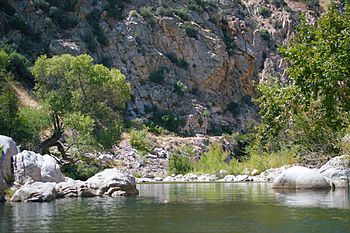Deep Creek (Mojave River tributary) facts for kids
Quick facts for kids Deep Creek |
|
|---|---|

At Deep Creek Hot Springs
|
|
| Other name(s) | East Fork Mojave River |
| Country | United States |
| State | California |
| County | San Bernardino |
| Physical characteristics | |
| Main source | Little Green Valley San Bernardino Mountains 7,512 ft (2,290 m) 34°14′19″N 117°02′55″W / 34.23861°N 117.04861°W |
| River mouth | Mojave River Mojave Forks Dam 2,992 ft (912 m) 34°20′29″N 117°14′15″W / 34.34139°N 117.23750°W |
| Length | 23.4 mi (37.7 km) |
| Basin features | |
| Basin size | 135 sq mi (350 km2) |
| Tributaries |
|
Deep Creek is a cool river, or tributary, that flows into the Mojave River in San Bernardino County, California. It's about 23.4 miles (37.7 km) long. This creek is known for its beautiful natural areas and fun spots like hot springs and waterfalls.
Contents
Deep Creek: A California River
Deep Creek is an important part of the natural landscape in Southern California. It provides water and a home for many plants and animals. It's also a popular spot for people who love hiking and exploring the outdoors.
Where Does Deep Creek Start and End?
Deep Creek begins high up in the San Bernardino Mountains. Its source is in a place called Little Green Valley, at an elevation of about 7,512 feet (2,290 m). That's pretty high!
- Starting point: It first flows southwest through small towns like Arrowbear and Running Springs.
- Changing direction: Then, it turns north.
- Joining other waters: Hooks Creek joins Deep Creek from the west. A dam on a smaller creek, Little Bear Creek, creates Lake Arrowhead.
- Ending point: Deep Creek finally meets the West Fork Mojave River to form the main Mojave River. This meeting point is about 10 miles (16 km) southeast of Hesperia. It's right behind the Mojave Forks Dam, which was built in 1974 to help control floods.
What Can You See Along Deep Creek?
Deep Creek flows through some amazing places. It carves a deep valley, or gorge, through mountains.
- Aztec Falls: A short distance downstream from where Hooks Creek joins, you'll find Aztec Falls. This is a popular spot where people go swimming at the waterfall.
- Deep Creek Hot Springs: Further along, where the creek turns west, are the famous Deep Creek Hot Springs. These are natural hot pools where you can relax.
- Pacific Crest Trail: The famous Pacific Crest Trail follows the Deep Creek canyon for about 16 miles (26 km). This means hikers on this long trail get to enjoy the beautiful views along the creek.
Deep Creek's Natural World
The area around Deep Creek is called its drainage basin. This is the land where all the rain and snowmelt eventually flow into the creek. Deep Creek's drainage basin is about 135 square miles (350 km²) in size. Most of this area is part of the San Bernardino National Forest.
- Mountain Stream: For most of its journey, Deep Creek is a fast-flowing mountain stream. Its bed has deep pools and many large rocks, or boulders.
- Water Flow: The creek gets most of its water from snow melting in the winter and spring. In the autumn, the water levels are usually very low.
- Flash Floods: Sometimes in the summer, big storms can cause flash floods. This means the water level in the creek can rise very quickly and powerfully.
Deep Creek is a very special place because it has many different kinds of plants and animals. It's one of the most ecologically diverse areas in the San Bernardino National Forest.
Plants and Trees
The types of plants you see depend on how high up you are along the creek:
- Lower elevations: Closer to the Mojave Desert, you'll find plants like chaparral, creosote bush, chamise, and California buckwheat. These plants are good at living in dry areas.
- Middle elevations: Here, you'll see oak trees and pinyon-juniper woodland.
- Highest elevations: In the highest parts, there are mixed conifer forests, with different types of pine and fir trees.
Amazing Animals
Deep Creek is home to some cool creatures:
- Southwestern Arroyo Toad: An endangered type of toad, the southwestern arroyo toad, lives in the lower parts of Deep Creek. This means it's very important to protect their home.
- Wild Trout: The state of California has named Deep Creek a "Wild Trout Stream." This means it's a great place for fishing, and you can find different types of trout, like rainbow and brown trout.

